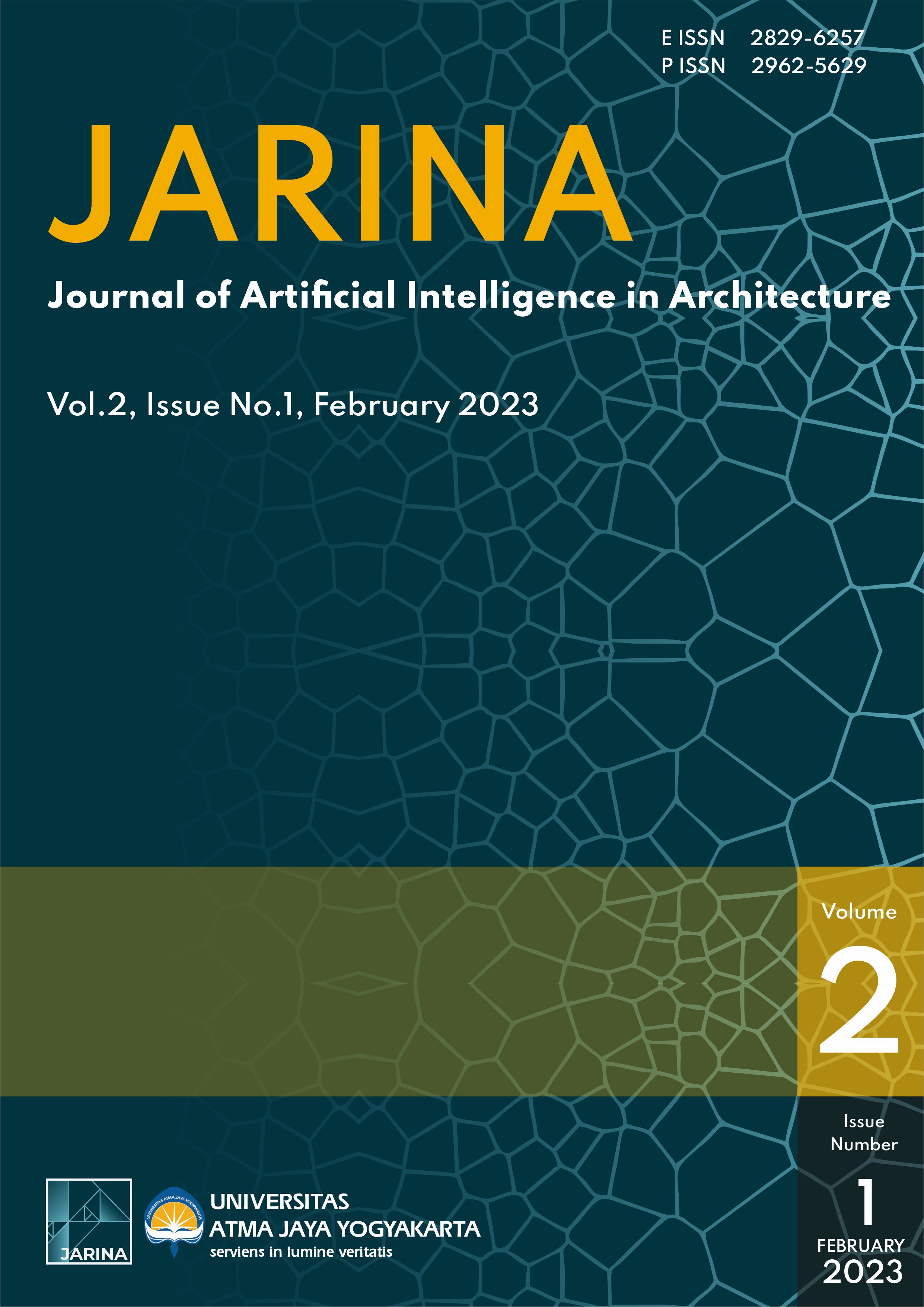A Modeling of Occupational Therapy Room Prototypes for Mental Disorders
DOI:
https://doi.org/10.24002/jarina.v2i1.6601Keywords:
Neuroarchitecture, Virtual Reality Interior, Mental Disorder, ODGJ, Occupational therapyAbstract
People with Mental Disorders (ODGJ) are less likely to recover completely. Still, there is a chance to recover and return to their normal activities Therapy that can make people with mental disorders carry out activities like ordinary people is occupational therapy. However, Indonesia still needs to offer an occupational therapy room design that can support the therapeutic process. This research developed an occupational therapy room modeling that can help the recovery process of people with a mental health condition with a neuroarchitecture approach through a 360o panoramic illustration. This research collects data from reliable sources regarding people with mental disorders, health workers, occupational therapy, neuroarchitecture, and theories regarding visual, texture, thermal, aroma, and audial. After that, space exploration is carried out based on ergonomics and considers the patient's senses. Based on the analysis results, it produces several rooms: outdoor areas, individual therapy rooms, group therapy rooms, entertainment rooms, work rooms, and toilets. The illustration of space modeling shows the use of interior elements such as the dominant color of the space, green and blue, the placement of high ceilings in the room that accommodates creative activities, and the low ceiling for the room accommodates privacy activities. In addition, space modeling also shows the type and placement of the furniture in every kind of space. Doctors or health experts can consider this modeling when making interior design guidelines for occupational therapy rooms.
References
PUSAT DATA DAN INFORMASI KEMENTERIAN KESEHATAN RI, Info Datin Kesehatan Jiwa. 2019.
واﻟﻔﻧون اﻟﻌﻣﺎرة ﻣﺟﻠﺔ ال اﻟﻌدد راﺑﻊ ﻋﺷر Neuroscience: and Design Interior of Integration "The Ibrahim, Mahmoud Maha A. [2]
.Towards a Methodology to Apply Neuroscience in Interior Spaces", doi: 10.12816/mjaf.2019.25813
P. Rumah et al., "The Role of Mahogany Mental Hospital in Restoring the Social Functions of Ex People with Mental Disorders," 2020. [Online]. Available: http://jurnal.umsu.ac.id/index.php/JISP
F. Rinawati et al., “ANALISA FAKTOR-FAKTOR PENYEBAB GANGGUAN JIWA MENGGUNAKAN PENDEKATAN MODEL ADAPTASI STRES STUART,” Jurnal Ilmu Kesehatan, vol. 5, no. 1, 2016.
S. Gunarsa and dkk, Psikologi Olahraga Teori Dan Praktik. Jakarta: PT. BPK Gunung Mulia, 1998.
M. P. Drs. Kuntjojo, “PSIKOLOGI ABNORMAL,” 2009.
J. Smucny, D. C. Rojas, L. C. Eichman, and J. R. Tregellas, "Neural Effects of Auditory Distraction on Visual Attention in Schizophrenia," PLoS One, vol. 8, no. 4, Apr. 2013, doi: 10.1371/JOURNAL.PONE.0060606.
M. Kohn, D. Hitch, and K. Stagnitti, "Better Access to Mental Health program: Influence of mental health occupational therapy," Aust Occup Ther J, vol. 59, no. 6, pp. 437–444, Dec. 2012, doi: https://doi.org/10.1111/1440-1630.12005.
J. McQueen, "Creek's occupational therapy and mental health, 5th edition," British Journal of Occupational Therapy, vol. 77, p. 634, 2014, [Online]. Available: https://link.gale.com/apps/doc/A394685519/AONE?u=googlescholar&sid=bookmark-AONE&xid=7bdb6af7
K. Wright, T. Armstrong, A. Taylor, and S. Dean, "‘It’s a double edged sword’: A qualitative analysis of the experiences of exercise amongst people with Bipolar Disorder,” J Affect Disord, vol. 136, no. 3, pp. 634–642, 2012, doi: https://doi.org/10.1016/j.jad.2011.10.017.
J. Barton and J. Pretty, “What is the Best Dose of Nature and Green Exercise for Improving Mental Health? A Multi-Study Analysis,” Environ Sci Technol, vol. 44, no. 10, pp. 3947–3955, May 2010, doi: 10.1021/es903183r.
M. Matoso, “Neuroarchitecture: How Your Brain Responds to Different Spaces,” May 26, 2022.
I. H. Marysa and A. W. Anggraita, “Studi Pengaruh Warna pada Interior Terhadap Psikologis Penggunanya, Studi Kasus pada Unit Transfusi Darah Kota X,” 2016. [Online]. Available: http://www.slideshare.net/AndhikaFrancisco/donor-darah-ppt
F. Birren, Colour Psychology and Colour Therapy. . New York: University Book Inc., 1961.
B. Tao, S. Xu, X. Pan, Q. Gao, and W. Wang, “Personality trait correlates of color preference in schizophrenia,”
Transl Neurosci, vol. 6, no. 1, pp. 174–178, Jul. 2015, doi: 10.1515/tnsci-2015-0018.
P. Satwiko, FISIKA BANGUNAN. 2008.
J. M. Walch, B. S. Rabin, R. Day, J. N. Williams, K. Choi, and J. D. Kang, “The Effect of Sunlight on Postoperative Analgesic Medication Use: A Prospective Study of Patients Undergoing Spinal Surgery,” Psychosom Med, vol. 67, no. 1, 2005, [Online]. Available:https://journals.lww.com/psychosomaticmedicine/Fulltext/2005/01000/The_Effect_of_Sunlight_on_Postopera tive_Analgesic.22.aspx
C. von Castell, H. Hecht, and D. Oberfeld, “Wall patterns influence the perception of interior space,” Quarterly Journal of Experimental Psychology, vol. 73, no. 1, pp. 29–54, Sep. 2019, doi: 10.1177/1747021819876637.
J. P. McGann, “Poor human olfaction is a 19th-century myth,” Science, vol. 356, no. 6338. American Association for the Advancement of Science, May 12, 2017. doi: 10.1126/science.aam7263.
“Place Advantage Applied Psychology for Interior Architecture (Sally Augustin, Neil Frankel, Cindy Coleman) (z-lib.org)”.
T. Matsumoto, H. Asakura, and T. Hayashi, “Effects of Olfactory Stimulation from the Fragrance of the Japanese Citrus Fruit Yuzu (Citrus junos Sieb. ex Tanaka) on Mood States and Salivary Chromogranin A as an Endocrinologic Stress Marker,” The Journal of Alternative and Complementary Medicine, vol. 20, no. 6, pp. 500–506, Apr. 2014, doi: 10.1089/acm.2013.0425.
A. Haehner, H. Maass, I. Croy, and T. Hummel, “Influence of room fragrance on attention, anxiety and mood,”
Flavour Fragr J, vol. 32, no. 1, pp. 24–28, Jan. 2017, doi: https://doi.org/10.1002/ffj.3339.
B. Goldstein and L. Cacciamani, Sensation and Perception, 11th ed. Cengage Learning, 2021.
Volpe U et al., “Acute Effects of Music Therapy in Subjects With Psychosis During Inpatient Treatment. Psychiatry.,” pp. 218–227, 2018, Accessed: Jul. 27, 2022. [Online]. Available: 10.1080/00332747.2018.1502559.
S. Koelsch, “Brain correlates of music-evoked emotions,” Nature Reviews Neuroscience, vol. 15, no. 3. pp. 170–180, Mar. 2014. doi: 10.1038/nrn3666.
E. C. Sulistyowati, “PENGARUH TERAPI MUSIK TERHADAP PERUBAHAN PERILAKU PADA PASIEN SKIZOPRENIA DENGAN PERILAKU KEKERASAN DI RUMAH SAKIT JIWA DAERAH SURAKARTA,” 2011, Accessed: Jul. 27, 2022. [Online]. Available: https://lib.ui.ac.id/file?file=digital/2016-11/124781-Endang%20Caturini%20Sulistyowati.pdf
A. A. WICAKSONO and TISNAWATI ENDAH, TEORI INTERIOR. 2014.
V. Presta et al., “Posture and gait in the early course of schizophrenia,” PLoS One, vol. 16, no. 1 January, Jan. 2021, doi: 10.1371/journal.pone.0245661.

Downloads
Published
How to Cite
Issue
Section
License
Copyright (c) 2023 Brigitha Watuseke

This work is licensed under a Creative Commons Attribution 4.0 International License.
Authors who publish with this journal agree to the following terms:
1.Authors retain copyright and grant the journal right of first publication with the work simultaneously licensed under a Creative Commons that allows others to share the work with an acknowledgement of the work's authorship and initial publication in this journal.
2.Authors are able to enter into separate, additional contractual arrangements for the non-exclusive distribution of the journal's published version of the work (e.g., post it to an institutional repository or publish it in a book), with an acknowledgement of its initial publication in this journal.
3.Authors are permitted and encouraged to post their work online (e.g., in institutional repositories or on their website) prior to and during the submission process, as it can lead to productive exchanges, as well as earlier and greater citation of published work (See The Effect of Open Access).
















